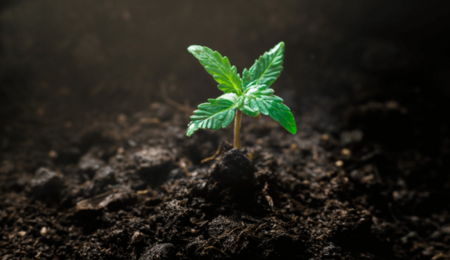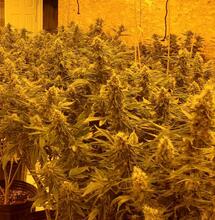The Foliage Growth Stage

Everyone likes to see big, bushy marijuana plants. But how do you get the thick, bright green foliage you see in pictures? Well, read on. Here’s the facts about the foliage growth period.
The first step to extensive foliage growth is simple nutrition. You want to provide enough nutrition to your plants so they have the energy to climb both upwards as well as outwards. The nutrient solution has to be replaced every day for the plants to grow to their full potential. The roots guzzle up nutrient but leave behind harmful salts. Changing the nutrient solution daily and adjusting its pH level is very important to future growth.
Adequate lighting is also a major concern. You would normally use a 400 watt metal halide lamp for 5 plants and under and a 1000 watt metal halide lamp for those crops that are 6 plants and over. Most new growers tend to hang the lamp too close to the tops of the plants, which dries out and scars the topmost leaves. If you see the topmost leaves or even buds go brown, raise the lamp. Be prepared to lift the lamp higher every 3 or 4 days. A typical cannabis plant is just over a meter (3 to 4 feet) in height, so you won’t have to lift your lamp right to the ceiling.
 There are basically three different types of lighting: metal halide, high pressure sodium and LEDs. I recommend metal halide, as its spectrum mimics the noon sun on a summer day. This is exactly what your cannabis needs for prolific growth. Some might say that high pressure sodium is better for bud growth, but I’ve found that isn’t the case. The only change to your growing regimen when the foliage growth period turns into the budding stage should be the duration of light. The foliage growth period requires your lamps to be on an 18 hours on and 6 hours off schedule. When the budding stage shows, change the light duration to 12 hours on and 12 hours off. This mimics the waning sun of autumn, which is when the cannabis plant is at its peak in the wild.
The high intensity LED lamp is great for growing, but as it is a new technology it’s still fairly expensive. Don’t confuse high intensity LEDs with the little lights shown on your electronics – while similar, they are different in a few key areas. The amount of power used requires a slightly different way of thinking.
These tips will help the crop along immensely. Following these simple rules will make the growing experience an enjoyable and fruitful experience.
There are basically three different types of lighting: metal halide, high pressure sodium and LEDs. I recommend metal halide, as its spectrum mimics the noon sun on a summer day. This is exactly what your cannabis needs for prolific growth. Some might say that high pressure sodium is better for bud growth, but I’ve found that isn’t the case. The only change to your growing regimen when the foliage growth period turns into the budding stage should be the duration of light. The foliage growth period requires your lamps to be on an 18 hours on and 6 hours off schedule. When the budding stage shows, change the light duration to 12 hours on and 12 hours off. This mimics the waning sun of autumn, which is when the cannabis plant is at its peak in the wild.
The high intensity LED lamp is great for growing, but as it is a new technology it’s still fairly expensive. Don’t confuse high intensity LEDs with the little lights shown on your electronics – while similar, they are different in a few key areas. The amount of power used requires a slightly different way of thinking.
These tips will help the crop along immensely. Following these simple rules will make the growing experience an enjoyable and fruitful experience.
 There are basically three different types of lighting: metal halide, high pressure sodium and LEDs. I recommend metal halide, as its spectrum mimics the noon sun on a summer day. This is exactly what your cannabis needs for prolific growth. Some might say that high pressure sodium is better for bud growth, but I’ve found that isn’t the case. The only change to your growing regimen when the foliage growth period turns into the budding stage should be the duration of light. The foliage growth period requires your lamps to be on an 18 hours on and 6 hours off schedule. When the budding stage shows, change the light duration to 12 hours on and 12 hours off. This mimics the waning sun of autumn, which is when the cannabis plant is at its peak in the wild.
The high intensity LED lamp is great for growing, but as it is a new technology it’s still fairly expensive. Don’t confuse high intensity LEDs with the little lights shown on your electronics – while similar, they are different in a few key areas. The amount of power used requires a slightly different way of thinking.
These tips will help the crop along immensely. Following these simple rules will make the growing experience an enjoyable and fruitful experience.
There are basically three different types of lighting: metal halide, high pressure sodium and LEDs. I recommend metal halide, as its spectrum mimics the noon sun on a summer day. This is exactly what your cannabis needs for prolific growth. Some might say that high pressure sodium is better for bud growth, but I’ve found that isn’t the case. The only change to your growing regimen when the foliage growth period turns into the budding stage should be the duration of light. The foliage growth period requires your lamps to be on an 18 hours on and 6 hours off schedule. When the budding stage shows, change the light duration to 12 hours on and 12 hours off. This mimics the waning sun of autumn, which is when the cannabis plant is at its peak in the wild.
The high intensity LED lamp is great for growing, but as it is a new technology it’s still fairly expensive. Don’t confuse high intensity LEDs with the little lights shown on your electronics – while similar, they are different in a few key areas. The amount of power used requires a slightly different way of thinking.
These tips will help the crop along immensely. Following these simple rules will make the growing experience an enjoyable and fruitful experience.
S
Soft Secrets



